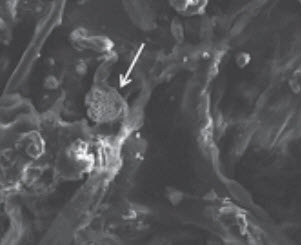Could fossils be discovered on the Moon?
August 4, 2014

(Credit: Janet Ramsden)
University of Kent physicists have tested what would happen if a piece of rock containing microscopic fossils from Earth was launched into space and hit the surface of the moon.
Professor Mark Burchell and researchers from Kent ’s Centre for Astrophysics simulated the condition that fossilized diatoms — microscopic algae with detailed shells — might have faced if traveling from earth to the moon.
The team turned fossil-filled rock into powder that was mixed with water and frozen to replicate a meteoroid.

Example of intact diatom fossil in hypervelocity impact experiment (credit: M. J. Burchell et al./Philosophical Transactions of the Royal Society A)
The replica meteoroid was then fired into a bag of water using a large gas-powered gun to allow it experience the impact of being launched into orbit.
The rapid deceleration and high pressure as it hit the water simulated how it might have smashed into the moon at high speed. The fossils survived.
This research, published in Philosophical Transactions of the Royal Society A (open access), suggests that if Earth meteorites are ever found on the moon — in the same way that we find lunar meteorites on Earth — they may contain fossils from the Earth’s past.
Abstract of Philosophical Transactions of the Royal Society A: Mathematical, Physical and Engineering Sciences paper
Experimental data are shown for survival of fossilized diatoms undergoing shocks in the GPa range. The results were obtained from hypervelocity impact experiments which fired fossilized diatoms frozen in ice into water targets. After the shots, the material recovered from the target water was inspected for diatom fossils. Nine shots were carried out, at speeds from 0.388 to 5.34 km s−1, corresponding to mean peak pressures of 0.2–19 GPa. In all cases, fragmented fossilized diatoms were recovered, but both the mean and the maximum fragment size decreased with increasing impact speed and hence peak pressure. Examples of intact diatoms were found after the impacts, even in some of the higher speed shots, but their frequency and size decreased significantly at the higher speeds. This is the first demonstration that fossils can survive and be transferred from projectile to target in hypervelocity impacts, implying that it is possible that, as suggested by other authors, terrestrial rocks ejected from the Earth by giant impacts from space, and which then strike the Moon, may successfully transfer terrestrial fossils to the Moon.